Educational Video on C-V2X
The C-V2X technology is set to revolutionise the mobility ecosystem and the way drivers interact with the world. It is essential to redefining transportation by providing real-time, highly reliable, and actionable information flows to enable safety, mobility and environmental applications.
5GAA believes C-V2X is key to achieving the level of connectivity required for V2X communication, and set to be a disruptive force in the automotive market.
Discover more on C-V2X technology in the video below.

5GAA board submits feedback on the C-ITS delegated regulation proposed by the European Commission
The 5G Automotive Association (5GAA) board took part in the public consultation launched by the Directorate General Directorate-General for Mobility and Transport (DG MOVE) of the European Commission on the C-ITS delegated regulation.
The consultation has 100 comments from individuals, associations and companies. In fact, some 5GAA members have submitted their own feedback. The variety of comments proves that there are clearly opposing positions regarding this regulation.
Concretely, in the submitted feedback, the 5GAA board calls upon the Commission to:
- Amend the draft Delegated Regulation to include LTE-V2X both short-range and long-range communications, via the related ETSI approved specifications and profiles on an equal footing with ITS-G5;
- Define interoperability as a “mutual” requirement among mature C-ITS technologies, namely ITS-G5 and LTE-V2X for short & long-range communications;
- Avoid legal uncertainty on the “fast-track” update process by:
– Introducing a 6-month deadline for the Commission to make its decision publicly known as regards the initiation of an amendment procedure to include new technologies (e.g., 5G-V2X) or new C-ITS services;
– Specifying clearly the terms, conditions and processes for the inclusion of other technologies (e.g. 5G-V2X) or C-ITS services, including unambiguous definitions of terms such as “existing”, “maturity” or “migration path”, etc.;
– Include as an Annex to the Delegated Regulation a template for the “technical file” to be submitted;
– Open up participation in the future C-ITS Expert Group to representatives of technology segments that are not within the scope of the draft Delegated Regulation today. - We note that all elements required in the proposed process for updating the draft Regulation are already met by LTE-V2X:
– All required profiles/technical specifications for LTE-V2X have been adopted by European SDOs;
– Multiple vendors have already commercialised LTE-V2X short-range hardware and software solutions in Q1 2019 (and more are announced for Q2 2019); - We also underline that many of the C-ITS priority services listed in Annex I of the draft Delegated Regulation have already been implemented using 3G and 4G (LTE) cellular networks for long-range communications (e.g. traffic jams, weather conditions, road works, etc.). Yet, this reality is not accounted for by the draft text which still only foresees the initial deployment of these services exclusively via ITS-G5 for short-range communications.
Read the full feedback submitted by the 5GAA board here.
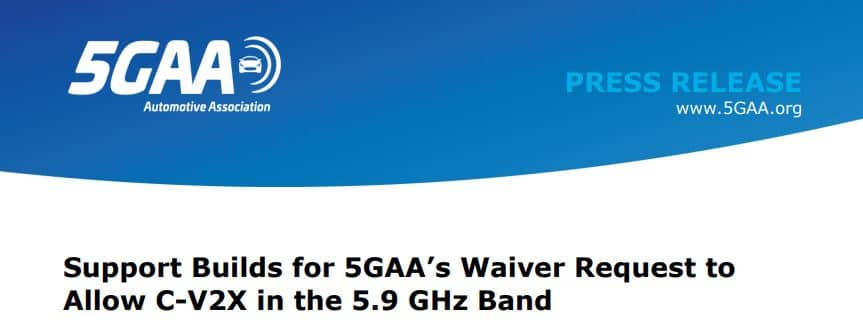
US Support Builds for 5GAA’s Waiver Request to Allow C-V2X in the 5.9 GHz Band
Stakeholders from the automobile, wireless, and technology industries filed comments at the US Federal Communications Commission (FCC) in support of the 5G Automotive Association’s waiver request seeking permission to deploy Cellular Vehicle-to-Everything (C-V2X) technology in a portion of the 5.9 GHz band.
Click here to have a look at the official press release.
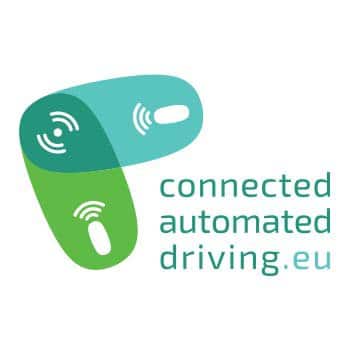
5GAA joins EU ARCADE Project as Associated Partner
The 5G Automotive Association (5GAA) has become an Associate Partner of the Aligning Research & Innovation for Connected and Automated Driving in Europe (ARCADE) funded by the European Commission. The project aims at building consensus across stakeholders to enable a smooth deployment of connected and automated driving (CAD) on European roads and beyond.
By joining this project, 5GAA reinforces its commitment to the efforts made by the European Commission, Member States and other industry actors to create a common approach to ensure the further development testing, validation and deployment of CAD in Europe and beyond.
5GAA will use the collective expertise of the association to participate and contribute knowledge at both the European and international level. 5GAA look forward to exchanging views and experiences with the wide range of other expert groups and stakeholders involved as partners of the project.
The ARCADE project will run for three years and aims to establish a joint stakeholders forum to coordinate and harmonise automated road transport approaches at both the European and the international level (in particular with the US and Japan). Towards this objective, ARCADE will organise the Second European CAD conference in April 2019 in Brussels, in which 5GAA will be actively involved. Further details on the project can be found here.
5GAA members BMW Group, Bosch and Volvo Cars are among the principal partners already involved in this project funded under the Research and Innovation Framework Program of the European Commission (H2020) and 5GAA look forward to building upon these efforts.
See the list of all the ARCADE associated partners.

5GAA to hold joint workshop in partnership with 5G Forum & ITS Korea in Seoul, Korea
5GAA is kicking off 2019 with the first Working Group face-to-face meeting of the year, taking place in Seoul, Korea 28-31 January 2019; and as part of this meeting, 5GAA have organised a joint workshop in partnership with 5G-Forum and ITS Korea.
The event will kick-off with a signing of Memorandum of Understanding, to formalise cooperation between the three entities, and therefore to align their action in the field of connected mobility. The workshop will also involve presentations from other local Korean stakeholders including 5GAA Members from Korea including SK Telekom, KT, LG, and Samsung, followed byregional updates from 5GAA technical and polic developments.
For those of you that will join us, we look forward to seeing you soon, and for those who are unable to, 5GAA will be sure to update all our followers on the outcomes of the workshop shortly after the workshop.
About our 5GAA and our newest cooperative partners:
- 5G Forum aims to become the Korean leading force in the development of next-generation communications technology and contribute to the momentum of economic growth through the development of ICT industry in efforts to actualize the new administration’s agenda of the creative economy.
- ITS Korea promotes mutual cooperation among the public and private sectors for efficient implementation of ITS and contributes to the development of ITS field through various research, policy consultation, technology promotion, and business activities related to ITS.
- 5GAA (5G Automotive Association) is a global, cross-industry organisation bringing together the automotive and telecommunications industries. Since its creation in 2016, 5GAA has rapidly grown and counts +100 key players with a global footprint representing all major industry players around the world.
For more information, contact secretariat@5gaa.org
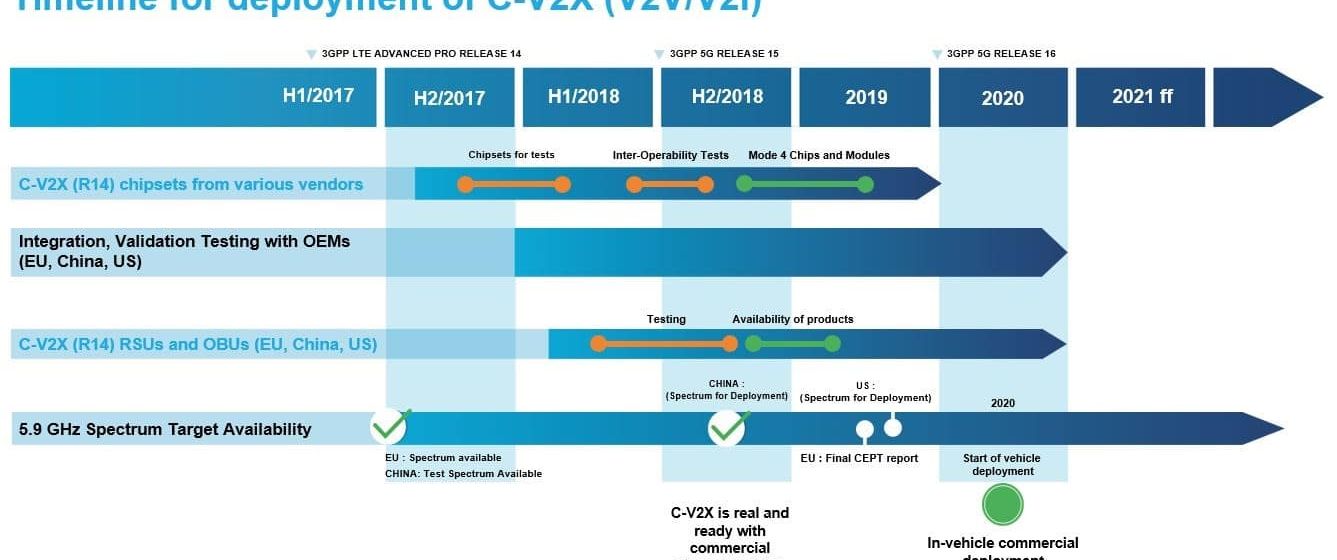
5GAA releases updated white paper on C-V2X Deployment Timeline
In December 2017 5GAA published the white paper “Timeline for deployment of LTE-V2X (V2V/V2I)” focusing on the introduction of direct communications with LTE 3GPP Rel.14. Since then Cellular-V2X (C-V2X) has gained a lot of momentum in the eco-system and we are at the verge of deploying the next generation of mobile network technology – 5G.
This updated timeline of the introduction of C-V2X covers the following topics:
- The extended use of V2N for safety-oriented services in vehicles deployed on the roads
- The comprehensive test and evaluation activities undertaken by the ecosystem consisting of OEMs, tier-1s, chip vendors, road operators, mobile operators as well as their suppliers and test equipment providers
- Outlook on the evolution towards 5G including backward compatibility
- C-V2X use cases for railways and respective test activities
- Progress on regulatory aspects
The inclusion of 2G, 3G and 4G cellular communication technologies (V2N – Vehicle2Network) into vehicles (i.e. “Connected Cars”) has been extremely successful in delivering benefits for the vehicle, the driver, the automaker and other participants in the transportation and emergency services ecosystem.
At present, more than 100 million Vehicles connected to cellular networks (V2N) are on the roads. This V2N connection is used for a wide variety of services including telematics, connected infotainment, real time navigation and traffic optimization, as well as for safety services including automatic crash notification (ACN) such as eCall, the recognition of slow or stationary vehicle(s) and informational alerts for events including traffic jams, road works and other traffic infrastructure related information, inclement weather conditions and other hazardous conditions. Several OEMs[i] share safety related warnings between their vehicles and have started to exchange this information across OEMs using e.g. services from HERE Technologies. Other initiatives to share information by interconnected backend systems are the EU financed projects ‘Nordic Way’, Talking Traffic’ and the ‘Drive Sweden projects. These projects also interconnect Road Traffic Authorities, Road operators, OEMs and smartphone applications to share traffic related info. The current understanding, also based on the European C-ITS Platform Final Report, is that the nature of these warning messages is informational, and the driver is always responsible.
C-V2X is a recent term introduced for cellular technologies optimized for transportation and connected vehicles. In particular, the C refers to both 4G LTE and 5G NR (new radio) releases of specifications, whereas X refers to multiple things’ vehicles may connect with. C-V2X includes both network-based communications that have been in use for decades, such as vehicle-to-network (V2N), as well as a new complementary mode of operation first defined in the 3GPP Release 14 specifications and approved in June 2017, which allows direct communications between vehicles (V2V), as well as between vehicle and road side infrastructure (V2I and I2V) without requiring any cellular network coverage or subscription. It can further support vulnerable road users (e.g. vehicle to pedestrian, or V2P) by integrating the direct communications technology into mobile and other devices. The direct communications functionality is used to specifically support safety critical services to reduce collisions, support automated driving, and improve traffic efficiency. LTE-V2X is the 3GPP nomenclature for direct communications as specified in releases 14 and 15, whereas 5G NR-V2X is from Release 16 onward. 3GPP R14 also added network communications improvements, delivering increased data volumes, managing greater scale of connected devices, and can further reduce latency and provide for higher levels of reliability in V2N. V2N is also technically known as Uu and refers to an endpoint such as a vehicle communicating with network infrastructure over operator licensed spectrum, whereas V2V/V2I/V2P is supported by direct communications operating on the ITS spectrum (e.g. 5.9GHz) and is known technically as PC5.
Click here to read the full version of this updated White Paper.
[i] https://www.autoblog.com/2018/05/07/volvo-cars-volvo-trucks-share-data/?guccounter=1#slide-7324246

5GAA releases white paper on the benefits of using existing cellular networks for the delivery of C-ITS
In this white paper, 5GAA provides analysis on the benefits of using existing cellular networks for the delivery of Cooperative Intelligent Transport Systems (C-ITS) services, in combination with RSU deployments. The analysis describes deployment options in terms of expenditures over a ten-year timeframe for the deployment of ITS services for vehicles communicating with infrastructure. For each option, the deployment costs, operation and maintenance cost, and connectivity costs are evaluated. The analysis highlights complementarity between cellular long-range technologies, i.e., mobile networks, using the cellular (Uu) interface and sidelink (PC5) technologies.
The paper defines the scope of services that can be reasonably delivered over cellular networks, and which services would require road side units (RSU) as an integral part of the solution. It also explains the state of the industry, highlighting examples where infrastructure services are already being provided over cellular networks today, as well as the architectural and technical considerations that are important to delivery of these services, such as spectrum, coverage, multi-operator and roaming agreements. The document details two different technical approaches: either build-out of dedicated RSU-based communication V2I infrastructure (C-V2X PC5 or 802.11p based ITS-G5/DSRC), or a mix of RSU and cellular based deployment. The cost models of these approaches are also analyzed, including the capital (CAPEX) and operational (OPEX) considerations that are important for road operators. These different models are applied to a variety of road scenarios to clearly show that the cost of delivering ITS services with existing cellular networks is significantly lower compared to widespread RSU rollout – to the extent that without this approach, it may not be reasonable to deploy V2I services in some areas at all.
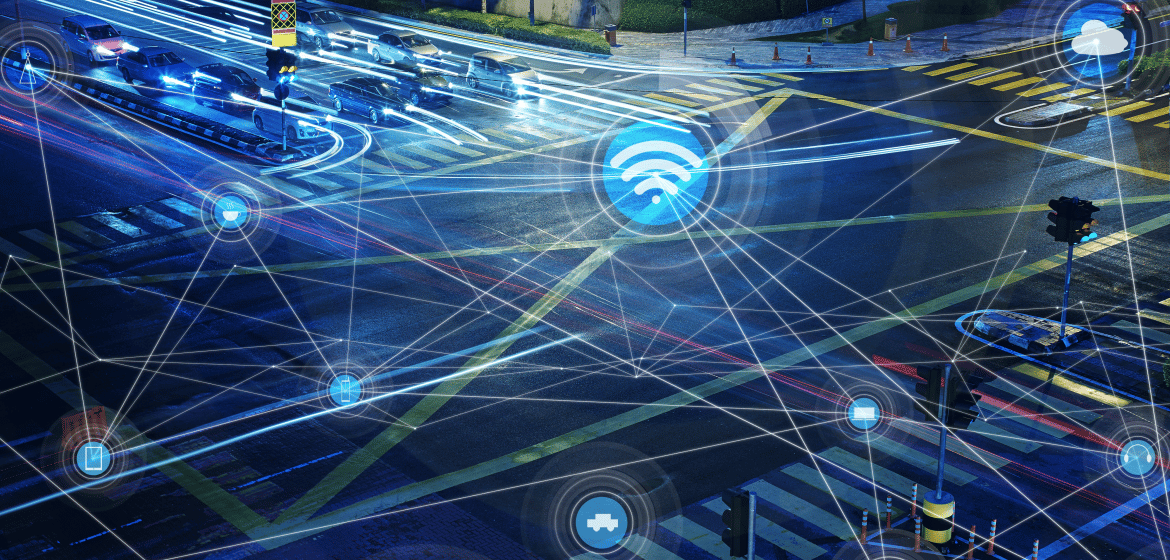
5G Automotive Association at CES 2019: Highlighting connected mobility through 5G
The 5G Automotive Association and 47 of its members will be present at CES 2019
LAS VEGAS – January 7, 2019 – The 5G Automotive Association (5GAA), the global, cross-industry organization of companies working together on future mobility solutions, will be at CES 2019 to discuss the future of transportation through 5G – including the critical role of Cellular Vehicle-to-Everything (C-V2X) deployment.
The 5G Automotive Association (5GAA) will be present at the Consumer Electronic Show (CES) 2019 on January 8-11 in Las Vegas. The global stage for innovation that has introduced breakthrough technologies over the past 50 years will have a special focus on autonomous and smart vehicles – from safety to policy roadmaps – and highlight the future of transportation through 5G. In other words, topics that 5GAA helps shaping across the world thanks to its network of over 100 members. And 47 of these leader companies of the telecommunications and automotive industries will help spread the message at the global stage event.
With a roll-out planned as early as 2020, 5GAA is pushing for the Cellular Vehicle-to-Everything (C-V2X) technology – technology that helps making roads safer while also laying the groundwork for fully automated vehicles. The technology has also been selected as a CES 2019 Innovation Award Honoree in the “Vehicle Intelligence and Self-Driving Technology” category. Some 5GAA members, like Qualcomm, will be driving discussions on the subject at high-level CES panel conferences such as SAE’s Connect2Car conference session on 5G/DSRC, Bluetooth, Wi-Fi. Audi, Ducati, Ford and Qualcomm with the support of other C-V2X ecosystem players will demonstrate advanced use cases enabled by C-V2X. Additionally, 5GAA members will highlight the achievement of significant milestones in the commercial introduction of C-V2X products.
When it comes to the application of the technology in the telecommunication industry:
- 5GAA founding member Ericsson will showcase its latest use of the C-V2X technology, demonstrating how the 4G/5G mobile networks will enable safety services for the connected vehicle and will be used to make self-driving cars a reality.
- Samsung and its subsidiary HARMAN will also showcase their scalable 5G Telematics module designed to enable wide-scale C-V2X communications.
- Working alongside the broad automotive and telecom ecosystems, Savari, Inc. will showcase its continued momentum in the development of its C-V2X real-time direct communications technology through its RSU and software stack. As an active member of the automotive association, Savari expects the 5G cellular compatible solution to bring benefits for road safety, automated driving and traffic efficiency as soon as 2020.
- Veniam and Bosch are both showcasing their jointly developed all-in-one central control unit for V2X data management and communication – together, the Veniam and Bosch solution demonstrates how to move massive amounts of data to, from and between vehicles on the road.
- With a deep focus on the technology, Wistron NeWeb Corporation (WNC) will showcase its 5G and C-V2X system and modular solutions designed to enable eco-system partners to promptly rollout in-vehicle and infrastructure applications.
- Continental will be showcasing a flexible 5G hybrid platform that allows both mobile network communication and rapid and reliable direct exchange of data. Depending on regional requirements and customer preferences, the platform enables C-V2X as well as Dedicated Short Range Communication. These benefits are being realized with a first customer award for this 5G-Hybrid-V2X solution.
As 2019 stands for the year for the connected cars ecosystem to prepare the ground for mass roll-out of the technology in 2020, 5GAA will be driving 5G innovation at CES as an official partner at the Allied Association corner located in South Hall 1. 5GAA representatives, including CTO Maxime Flament, will be available for briefings and interviews.
About 5GAA
The 5G Automotive Association (5GAA) is a global cross-industry organization of companies from the automotive, technology and telecommunications industries (ICT) working together to develop end-to-end solutions for future mobility and transportation services.
Created in 2016, the association includes over 100 members whose mission is to develop, test and promote communications solutions, initiate their standardization and accelerate their commercial availability and global market penetration, to address society’s connected mobility and road safety needs with applications such as automated driving, ubiquitous access to services and integration into smart city and intelligent transportation. For more information, visit 5GAA’s website, LinkedIn and Twitter pages.
Contact
Margaux Demeyer – Communications & Marketing
Tel: +32 (0)25882430
Mail: margaux.demeyer@5gaa.org
Marketing and Communications Team
Email: marcom@5gaa.org

Multi-stakeholder Statement on Preserving 5.9 GHz
The Association of Global Automakers, The Alliance of Automobile Manufacturers, 5G Automotive Association, Intelligent Transportation Society of America, and the American Association of State Highway and Transportation Officials issued the following statement in response to the recent filing by NCTA-The Internet & Television Association suggesting that spectrum reserved for transportation safety services should be repurposed:
The Association of Global Automakers, The Alliance of Automobile Manufacturers, The Intelligent Transportation Society of America, The 5G Automotive Association and The American Association of State Highway and Transportation Officials strongly support preserving the full 5.9 GHz band for transportation safety use, as it has been allocated.
Our members are actively developing technologies, and own and operate critical highway and other transportation infrastructure that connects vehicles to vehicles, to other road users, and to their environment to help reduce crashes. Connected vehicle and infrastructure technology includes vehicle communication with bicyclists, pedestrians, traffic lights, and advanced alerts of hazards like ice on roadways, commonly known as vehicle-to-everything (V2X). Additionally, they can enhance automated driving systems, which hold the promise to provide numerous economic, environmental, and societal benefits, such as decreased congestion and fuel consumption, and increased access for the elderly and disabled.
The entire 5.9 GHz band is needed to achieve the full benefit of these communication technologies in the years to come. These safety innovations require dedicated spectrum to ensure they work right every time without signal interference. Millions of dollars have already been invested in this effort, including incorporating connected vehicle technologies into infrastructure.
We are on the cusp of a major breakthrough in vehicle connectivity and safety innovations. With significant past and present investments in connected vehicle innovations, V2X technologies are already being deployed for the purposes of improving road safety. This will only continue moving forward. With 37,133 deaths on U.S. roadways last year alone, we must take every opportunity to save the lives of road users. Connected vehicle technologies offer the U.S. a powerful set of tools to save lives, but only if these technologies are given the ability to progress. We support protecting the entire 5.9 GHz band for transportation safety applications. Any unlicensed use in the band should be done without harmful interference to the incumbent technology or other intelligent transportation systems technologies.
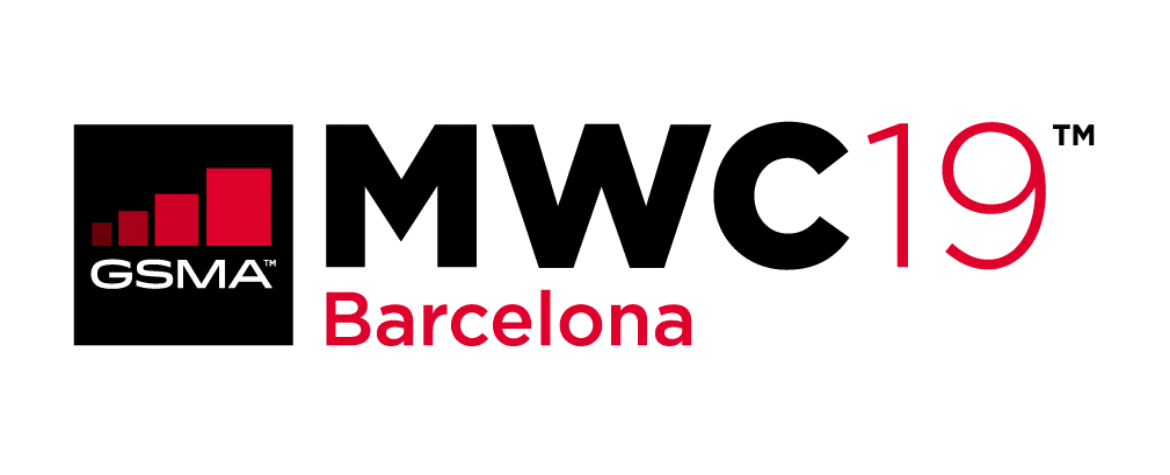
5GAA at MWC Barcelona 2019
MWC Barcelona 2019 is where over 100,000 of the tech industry’s innovators and influences will gather to explore how Intelligent Connectivity will shape the future of our digital experiences, our industry, and our world.
This time again, the 5G Automotive Association (5GAA) will lead the field of connected mobility by participating in the Congress. On Wednesday 27 February 2019 the association will host a morning session with leading automotive and telecommunications companies Worldwide. This a great opportunity to get updates and important insights from key industry players.
Following its participation at MWC Barcelona 2018, 5GAA is proud to continue the facilitation of such thought leadership platforms for relevant stakeholders, driving towards building a better mobility ecosystem.
Join us on Wednesday 27 February 2019 from 09:00 to 13:00 in Hall 8.0 Theatre F.
Learn more: www.mwcbarcelona.com
For more information, please contact marcom@5gaa.org


